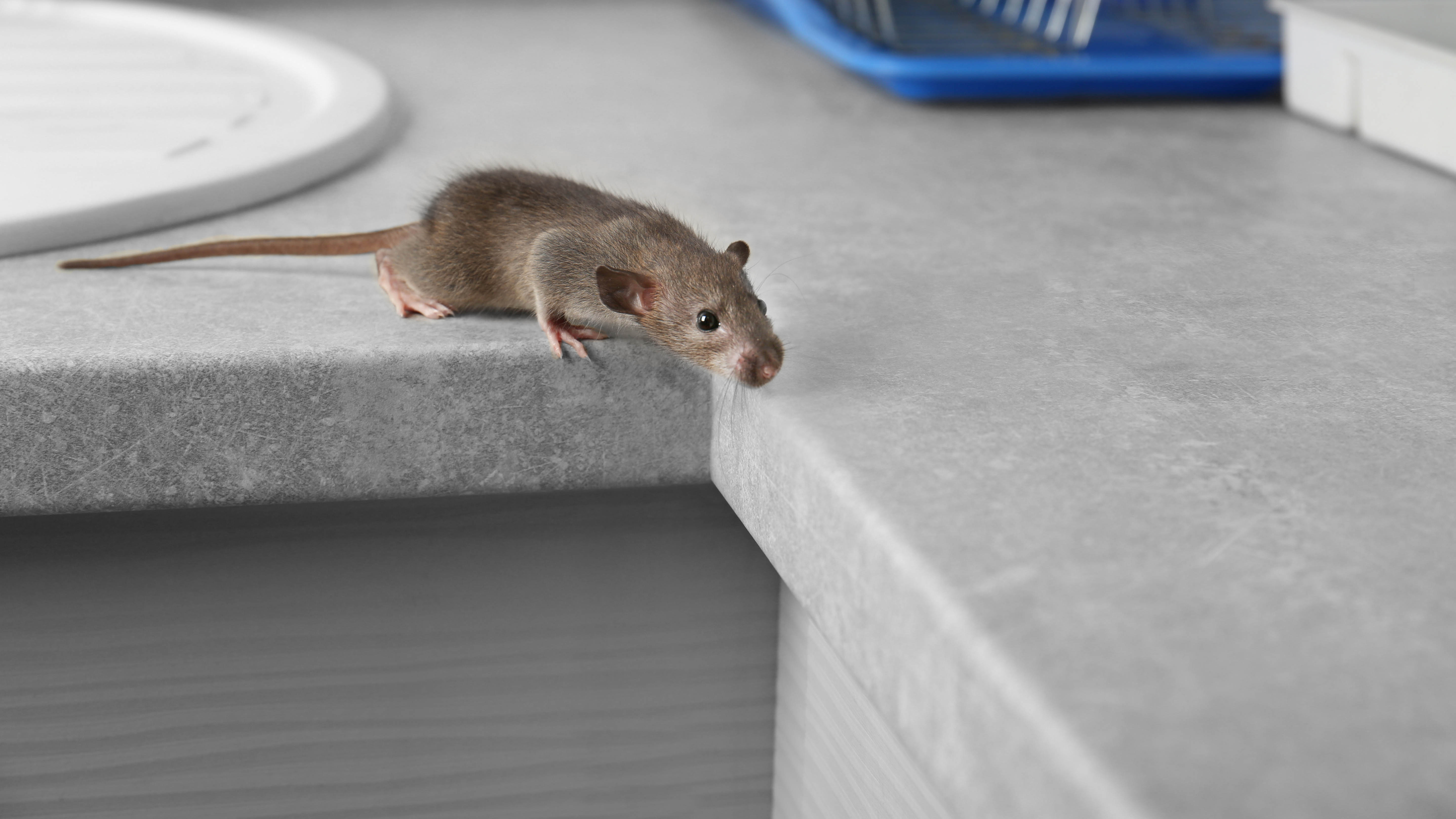How to get rid of mice in your home safely and keep them out
Here’s how to keep out those unwelcome pests for good

It can be a huge worry if you've spotted a mouse or mouse droppings in your home. And once you see one mouse, chances are, there’s an entire family wandering around! In this case, you'll need to know how to get rid of mice in your home safely and keep them out. Not only are they a nuisance, causing damage to your property, but they carry a host of diseases that can put your family's health at risk.
Knowing how to get rid of mice in your home might seem like a squeamish task, especially if you don’t want the conventional method of setting traps everywhere. But, there are safe and humane ways that are just as effective for eliminating mice. In fact, prevention is the key to deter mice from coming back. So if you don't want any unwanted rodents, follow these steps on how to get rid of mice in your home once and for all, but you'll want to avoid these 5 common mistakes to avoid when getting rid of mice.
Rats require alternative treatment, check out how to get rid of rats quickly and safely for guidance. Find out what are the 7 things that attract rats and mice to your home. And these are the 7 telltale signs you have mice in your home.
1. Eliminate all points of entry

As outdoor temperatures change, mice make their way inside homes, seeking shelter and warmth. They usually can fit through spaces as small as ¼ inch, so it’s important to find any potential entry points in the home they may be coming through. These could include holes or gaps in brickwork, baseboards, around pipes and vent openings. Block points of entry by sealing any small holes in your foundation, siding, and doorway by using caulk or weather-stripping such as Foam Insulation Tape, Weather Stripping Door Seal Strip ($13, Amazon), as a barrier.
Small gaps are one of the 7 things that are attracting pests to your home.
2. Remove all food sources

Alongside finding a warm sanctuary, mice need consistent food sources to sustain them. That means once they know where to find food, they’ll keep coming back for more. Remove any crumbs or food sources from the kitchen surfaces and floors, always cleaning up any spills or messes immediately. Seal all potential food sources in tamper-proof, glass or metal containers, making it hard for mice to chew through or get to. Avoid leaving pet food out for long periods, as that will attract rodents. It’s essential to maintain good sanitation, and know how to clean every room in your home.
3. Eliminate nesting areas

Mice live in warm nesting areas, and will often find materials in your home to make their nest. Ensure you store all fabric, rugs and blankets away, and dispose of cardboard, paper or any other recyclables. It’s common for mice to chew up cardboard, paper, or light plastic to make their nests. In addition, clear out any clutter, and make your space as clear as possible. For more tips, check out how to declutter your home in 5 steps.
Sign up to get the BEST of Tom's Guide direct to your inbox.
Get instant access to breaking news, the hottest reviews, great deals and helpful tips.
4. Buy mouse traps

Trapping is the fastest way to get rid of mice, but you might have to set multiple traps to catch just a few. There are conventional, wooden snap traps which are quick and effective, although you would have to dispose of the dead mouse. Or you can buy the more humane, live traps that can get rid of mice without poison or harm pests. These ‘catch-and-release’ mouse traps are large boxes that allow mice to get in but not out. One popular option on Amazon is the blink Humane Mouse trap ($12.99 for a set of two).
Once you’ve caught a mouse, you’d need to release it at least a mile from your home, or else it will find its way back. In any case, this is the more humane and safer option. Traps can be baited with peanut butter, seeds, nuts or dried fruit.
5. Place traps correctly

While it may seem simple enough, there is an effective way of placing mouse traps around the home. Lay the traps anywhere you see mice or signs such as rodent droppings or "rubbings" on baseboards and walls. Place the traps perpendicular to the walls, with the trigger section facing the baseboard. This will cause the mouse to run directly into the bait as it scurries along the walls, instead of running over the trap. Typically, mice don't travel more than 10 or 20 feet from their food sources and nesting areas.
6. Ultrasonic sound

Typically, mice are afraid of sonic and ultrasonic sounds. Ultrasonic units emit high-frequency waves that mice find uncomfortable, but humans and pets can’t hear. While they may not be as efficient as trapping, ultrasonic units like this Bell + Howell Ultrasonic Pest Repeller Home Kit ($19, Amazon), may be a good deterrent to stop mice coming back.
7. Deter with scents

Mice have a very strong sense of smell, much stronger than what humans have. So you can try these natural mice repellant options around the home. Typically, mice have an aversion to cinnamon, apple cider vinegar, dryer sheets, clove oil, peppermint, tea bags, mint toothpaste, ammonia, cloves, and cayenne pepper. Make a solution of apple cider vinegar and water, and put in a spray bottle. Spray around the perimeter of your house, as well as any indoor access points. Similarly, soak cotton balls with essential oils, and stick into any holes or entry points. Remember, these would need reapplying once the scent disappears.
8. Get a cat

This may sound cliche, but cats are one of the most effective mouse deterrents. If you don’t have a cat or your landlord won’t allow pets, simply borrow one from a friend! The key is to place tubs of used kitty litter at the entrances to your home. Since mice can smell the ammonia from cat urine, they may think there’s a predator there and not return.
With all that said, if you have a mice infestation on your hands, you would need to call in the exterminators right away. They are professionally trained to handle rodents and will advise you on the best course of action on how to get rid of mice.
How can you tell how many mice you have?

The main indication is if you see an excessive amount of droppings in key areas. This could mean that you're sharing your home with more than just one or two mice. In fact, the most likely place for you to find droppings is in the kitchen or dining areas where there are likely to be food sources.
Where do mice hide during the day?
If you’re wondering why you rarely spot mice during the day, it’s because they sleep hidden away in their nests. These are generally made of soft materials such as shredded paper, cardboard, insulation, or cotton. Mice usually build their nests in undisturbed, enclosed spaces, including unused drawers. So always clear out any unused and cluttered storage spaces.
Are you dealing with unwelcome guests in your backyard too? Here's how to get rid of moles without hurting them or how to get rid of squirrels without hurting them. You might also want to check out how to get rid of fruit flies quickly if you find any at home. Also find out the 10 things you didn't know you could clean with baking soda and also can I use malt vinegar for cleaning? — here is the best vinegar to clean with.

As the Homes Content Editor, Cynthia Lawrence covers all things homes, interior decorating, and garden-related. She has a wealth of editorial experience testing the latest, ‘must-have’ home appliances, writing buying guides and the handy ‘how to’ features.
Her work has been published in various titles including, T3, Top Ten Reviews, Ideal Home, Real Homes, Livingetc. and House Beautiful, amongst many.
With a rather unhealthy obsession for all things homes and interiors, she also has an interior design blog for style inspiration and savvy storage solutions (get rid of that clutter!). When she’s not testing cool products, she’ll be searching online for more decor ideas to spruce up her family home or looking for a great bargain!
